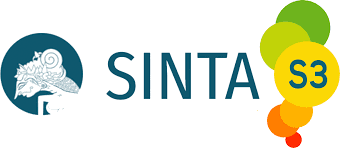PENGARUH PROPORSI KEPEMILIKAN INSTITUSIONAL INDUSTRI MANUFAKTUR INDONESIA TERHADAPDISCRETIONARY ACCRUALS MODEL JONES MODIFIKASI DENGAN UKURAN PERUSAHAAN SEBAGAI VARIABEL PEMODERASI
DOI:
https://doi.org/10.24002/modus.v29i2.1327Abstract
This study aimed to get empirical evidence about the influence of ownership structureinstitutionalmanufacture industry company on earnings management with the firm size as a moderating variable in the relationship between ownership structure company and discretionary accruals earnings management model Jones Modified. This research was carried out by using a sample of one hundred and fiveIndustri manufaktur companies listed on the Indonesian Stock Exchange (IDX) in 2012-2014. One indicator of corporate performance assessment is the amount of compensation received by the manager, where this can be the motivation of earnings management action. Earnings management measures can be minimized by monitoring the management by using the proportion of ownership by outsiders in the company.Earnings management is measured using the modified Jones models with discretionary accruals as a proxy for earnings management.
Statistical test equipment used in this research is multiple regression. This study obtained evidence that the structure of institutional ownership manufacture industry company has a significant negative effect on discretionary accruals earnings management, while the firm size is not able to moderate the influence of ownership structure manufacture industry on discretionary accruals earnings management of the company. This occurs because the IDX stock market ishave a capital market with companies that have large asset value so that the size of the company is not able to streng then the influence of ownership structure on earnings management action.
Keywords: Ownership StructureManufacture Industry, Firm Size, Discretionary Accruals Earnings Management and Modified Jones Model.
References
Anthony, R.N. & Vijay G. (1995). Management Control Systems. Irwin, Illinois: Homewood.
Belkaoui, A.R. (2000). Accounting Theory, 4th Edition. Boston, MA: Thomson Learning.
Cernat, L. (2004). The emerging European Corporate Governance Model: Anglo Saxon, Continental, or Still the Century of Diversity?. Journal of European Public Policy 11, 147-166.
Chin, C.L., Yu J.C, dan Tsun J.H. (2009). International Diversification, Ownership Structure, Legal Origin, and Earnings Management: Evidence from Taiwan. Journal of Accounting, Auditing and Finance (Spring) 24 (2), 233-362.
Dechow, P.M., Richard G.S., dan Amy P.S. 1995. Detecting Earnings Management. The Accounting Review 70 (2), 193-225.
Gujarati, D. (2003). Basic Econometrics 4th International Edition. Columbus, OH: McGraw-Hill.
Healy, P.M. (1985). The Effect of Bonus Schemes on Accounting Decisions. Journal of Accounting and Economics Vol. 7, 85-107
Iturriaga & Sanz. (2001). Ownership Structure, Corporate Value and Firm Investment: A Simultaneous Equations Analysis of Spanish Companies. Journal of Management and Governance Vol. 5 No. 2, 179-204.
Jensen & Meckling. (1976). The Agency Theory of The Firm: Managerial Behavior, Agency Cost and Owneship Structure. Journal of Financial Economics 3, 305-360.
Jones, C.P, Utama S., Frensidy B., Ekaputra I.A., Budiman R.U. (2009). Investment: Analysis and Management, an Indonesia Adoptation. Jakarta: Penerbit Salemba Empat dan John Willey.
Jones, J.J. (1991). Earning Management During Relief Investigation. Journal of Accounting Review 29 (2), 193-228.
Karolyi, A.G., (2004). The World of Cross-Listings and Cross-Listings of the World: Challenging Conventional Wisdom. Ohio: Fisher College of Bussines, The Ohio State Univesity.
Kumar, G., Mark W., dan Morris H.S. (2008). Voluntary accounting disclosures by US Listed Industri manufakturn Companies. Journal of International Accounting Research 7(1):25-50.
La Porta, R., Florencio L., Andrei S., dan Robert W.V. (1998). Law and Finance. Journal of political economy, Vol 106 No.6 pp. 1113-1155.
Leuz, C., Dhananjay N., dan Peter D.W. (2003). Earnings Management and Institutional Factors: An International Comparison. Journal of Financial Economics 69 (3), 505–527.
Moh’d, M.A., Perry, L.G, dan James R., (1998). The Impact of Owneship Structure on Corporate Debt Policy: A Time Series Cross-Sectional Analysis, Financial Review 33, 85-99.
Onyuma, S.O., Robert K.M., John K.K. (2012). Does Cross Border Listing (Still) Improve Firm Financial Performance in Eastern Africa?. Journal of Business, Economics & Finance Vol. 1 (1), 92-109.
Scott, W.R. (2003). Financial Accounting Theory 3th Edition. Upper Saddle River, NJ: Prentice Hall Inc. A Simon & Schuter Company.
Shleifer, A. and Vishny, R.W. (1986). Large Shareholders and Corporate Control. Journal of Political Economy 94, 461-488.
Siregar, S.V dan Utama, S. (2008). Type of Earnings Management and The Effect of Owneship Structure, firm size, and corporate-governance practices: Evidence from Indonesia. The Internasional Journal of Accounting 43, 1-27.
Subramanyam, K.R. (1996). The Pricing of Discretionary Accruals. Journal of Accounting and Economics 22 pp. 249-281.
Subramanyam, K.R. dan Wild, (2009). Financial Statement Analysis 9th Edition. New York: McGrawhill.
Wang, L., (2009). Ownership, Size, and The Formal Structure of Organizations: Evidence From US Public and Private Firms, 1992–2002. Industrial and Corporate Change, Vol. 18, No. 4, 595–636.
Watt, R.L., dan Zimmerman, J.L., (1986). Positive Accounting Theory. Englewood Cliff, NJ: Prentice-Hall Inc.














